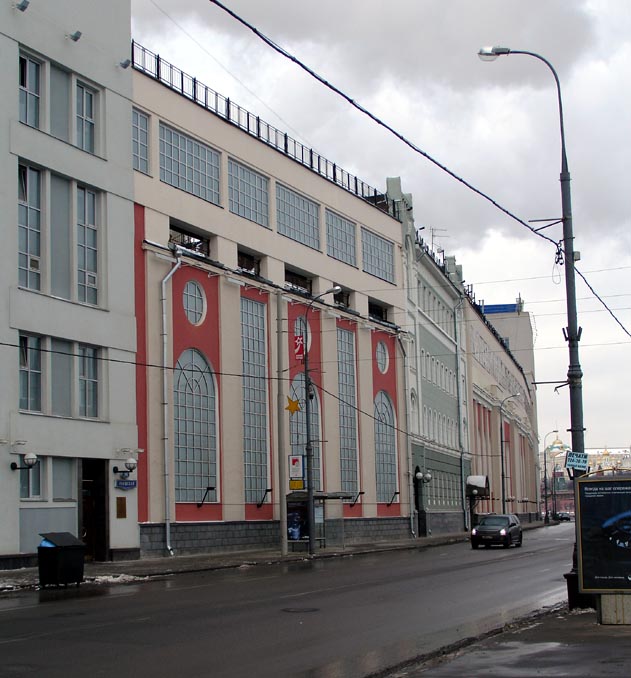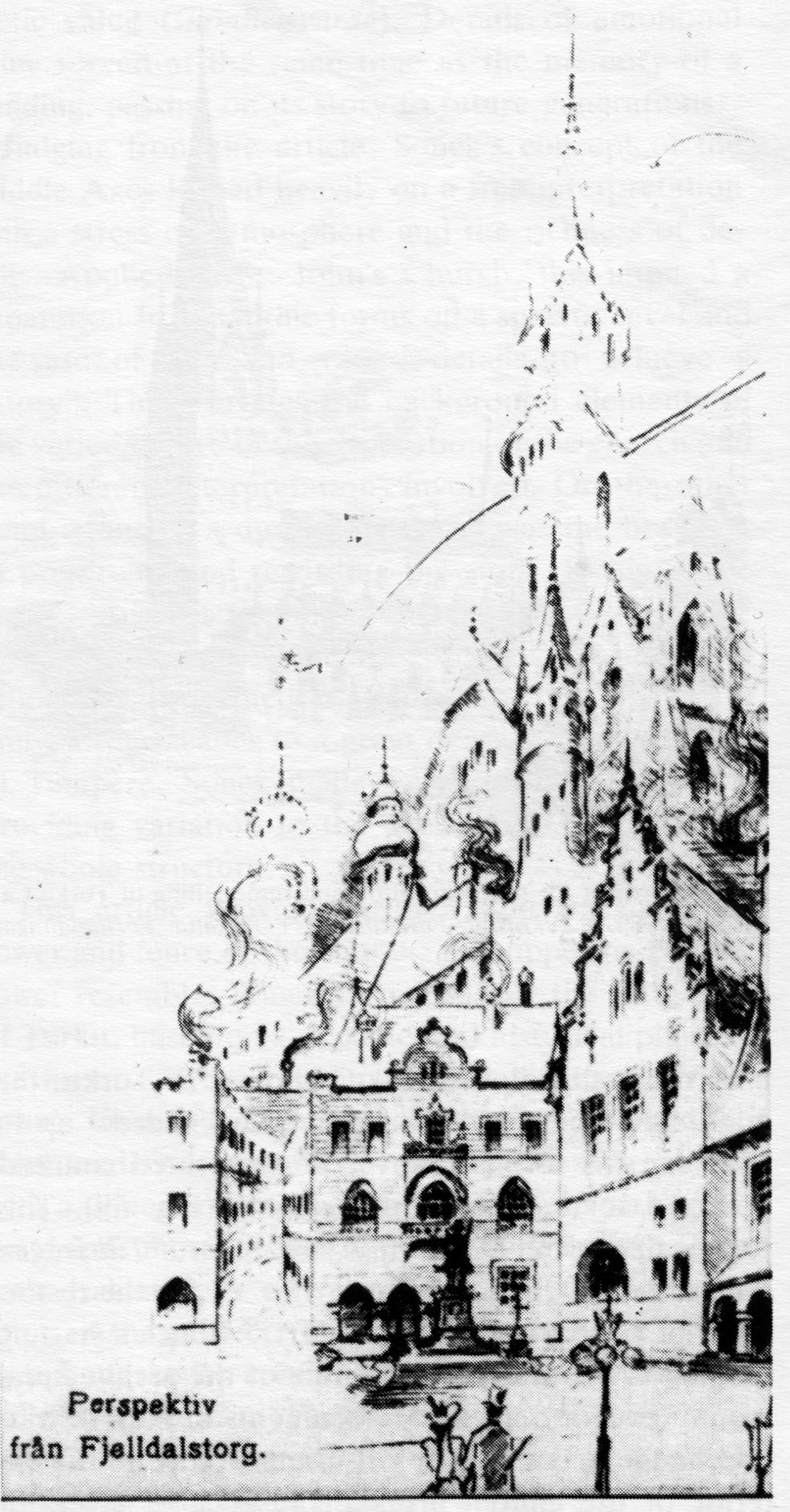|
Marian Peretyatkovich
Marian Marianovich Peretyatkovich (russian: –ú–į—Ä–ł–įŐĀ–Ĺ –ú–į—Ä–ł–įŐĀ–Ĺ–ĺ–≤–ł—á –ü–Ķ—Ä–Ķ—ā—ŹŐĀ—ā–ļ–ĺ–≤–ł—á; 23 August 1872, in Usychi (–£—Ā–ł—á—Ė in Ukrainian), Volhyn (now Ukraine) 22 May 1916, in Kyiv (Ukraine) was a Russian and Ukrainian architect. His premature death at the age of 43 limited his career to only eight years of independent practice (1908-1916), however, he managed to excel in a rational (Finnish) variety of late Art Nouveau, Renaissance Revival and Russian Revival in Saint Petersburg and Moscow. He is sometimes compared with Louis Sullivan on account of his insistence on functionality of office buildings. Biography Training Peretyatkovich trained at Saint Petersburg Institute of Civil Engineers, graduating in 1901, and the Imperial Academy of Arts under Leon Benois (1901-1906). Still at college, Peretyatkovich became famous as a refined draftsman; architect like Gavriil Baranovsky, Roman Klein and Ivan Rerberg hired him for drafting and interior designs. Thu ... [...More Info...] [...Related Items...] OR: [Wikipedia] [Google] [Baidu] |
Gavriil Baranovsky
Gavriil Vasilyevich Baranovsky (russian: –ď–į–≤—Ä–ł–ł–Ľ –í–į—Ā–ł–Ľ—Ć–Ķ–≤–ł—á –Ď–į—Ä–į–Ĺ–ĺ–≤—Ā–ļ–ł–Ļ, also spelled as Baranovskii, - ) was a Russian architect, civil engineer, art historian and publisher, who worked primarily in Saint Petersburg for the Elisseeff family, but also practiced in Moscow and produced the first town plan for Murmansk (then Romanov-na-Murmane). Biography Education and early career He was born in Odessa to attorney Vasili IvanovitŇ° Baranovsky and his wife Rosalia Malinovska Gavriil Baranovsky. Baranovsky trained at Saint Petersburg Institute of Civil Engineers (1881‚Äď1886), graduating with an honorary silver medal. He began his architectural career as an assistant to Paul Susor (Pavel Susor) between 1883 and 1885. His first commission was a state-financed Main Palace Chancellery (–ď–Ľ–į–≤–Ĺ–į—Ź –ī–≤–ĺ—Ä—Ü–ĺ–≤–į—Ź –ļ–į–Ĺ—Ü–Ķ–Ľ—Ź—Ä–ł—Ź); in 1885-1888, Baranovsky worked on numerous apartment buildings in Saint Petersburg. After 1888 he became staff arc ... [...More Info...] [...Related Items...] OR: [Wikipedia] [Google] [Baidu] |
Ivan Zholtovsky
Ivan Vladislavovich Zholtovsky (russian: –ė–≤–į–Ĺ –í–Ľ–į–ī–ł—Ā–Ľ–į–≤–ĺ–≤–ł—á –Ė–ĺ–Ľ—ā–ĺ–≤—Ā–ļ–ł–Ļ, be, –Ü–≤–į–Ĺ –£–Ľ–į–ī–∑—Ė—Ā–Ľ–į–≤–į–≤—Ė—á –Ė–į–Ľ—ā–ĺ—ě—Ā–ļ—Ė; November 27, 1867 ‚Äď July 16, 1959) was a Soviet and Russian architect and educator. He worked primarily in Moscow from 1898 until his death. An accomplished master of Renaissance Revival architecture before the Russian Revolution, he later became a key figure of Stalinist architecture. Early years Ivan Zholtovsky was born in Plotnitsa, Minsk Governorate (in present-day Belarus) November 27, 1867. He joined Academy of Arts in Saint Petersburg at the age of 20. Degree studies took 11 years till 1898 ‚Äď strapped for cash, Ivan used to take long leaves working as apprentice for the Saint Petersburg architectural firms. By the time of graduation, Zholtovsky had a first-rate practical experience in design, technology and project management. He retained this hands-on approach for the rest of his career, being a construction ... [...More Info...] [...Related Items...] OR: [Wikipedia] [Google] [Baidu] |
Constitutional Court Of Russia
A constitution is the aggregate of fundamental principles or established precedents that constitute the legal basis of a polity, organisation or other type of entity and commonly determine how that entity is to be governed. When these principles are written down into a single document or set of legal documents, those documents may be said to embody a ''written constitution''; if they are encompassed in a single comprehensive document, it is said to embody a ''codified constitution''. The Constitution of the United Kingdom is a notable example of an ''uncodified constitution''; it is instead written in numerous fundamental Acts of a legislature, court cases or treaties. Constitutions concern different levels of organizations, from sovereign countries to companies and unincorporated associations. A treaty which establishes an international organization is also its constitution, in that it would define how that organization is constituted. Within states, a constitution defines ... [...More Info...] [...Related Items...] OR: [Wikipedia] [Google] [Baidu] |
Sergei Rachmaninoff
Sergei Vasilyevich Rachmaninoff; in Russian pre-revolutionary script. (28 March 1943) was a Russian composer, virtuoso pianist, and conductor. Rachmaninoff is widely considered one of the finest pianists of his day and, as a composer, one of the last great representatives of Romanticism in Russian classical music. Early influences of Tchaikovsky, Rimsky-Korsakov, and other Russian composers gave way to a thoroughly personal idiom notable for its song-like melodicism, expressiveness and rich orchestral colours. The piano is featured prominently in Rachmaninoff's compositional output and he made a point of using his skills as a performer to fully explore the expressive and technical possibilities of the instrument. Born into a musical family, Rachmaninoff took up the piano at the age of four. He studied with Anton Arensky and Sergei Taneyev at the Moscow Conservatory and graduated in 1892, having already composed several piano and orchestral pieces. In 1897, following the d ... [...More Info...] [...Related Items...] OR: [Wikipedia] [Google] [Baidu] |
Ilya Golosov
Ilya Alexandrovich Golosov (Russian: –ė–Ľ—Ć—Ź –ź–Ľ–Ķ–ļ—Ā–į–Ĺ–ī—Ä–ĺ–≤–ł—á –ď–ĺ–Ľ–ĺ—Ā–ĺ–≤; 31 July 1883 ‚Äď 21 January 1945) was an architect from the late Russian Empire and early Soviet Union. A leader of Constructivism in 1925-1931, Ilya Golosov later developed his own style of early stalinist architecture known as postconstructivism. –Ě–Ķ was a brother of Panteleimon Golosov. Career Education, World War I, Revolution Golosov studied in the Stroganov School of Arts and Moscow School of Painting, Sculpture and Architecture, graduating in 1912. Before World War I, he trained in the workshops of Igor Grabar and Alexey Shchusev, and collaborated with Marian Peretyatkovich and Ivan Rerberg on Northern Insurance Buildings (Moscow). In 1914-1917 Golosov served as a military engineer. In 1918, Golosov joined Moscow state architectural office led by neoclassicist Ivan Zholtovsky, and stayed with him throughout the Civil war, at the same time teaching at the MVTU and VKhUTEMAS ... [...More Info...] [...Related Items...] OR: [Wikipedia] [Google] [Baidu] |
Vyacheslav Oltarzhevsky
Vyacheslav Konstantinovich Oltarzhevsky (russian: –í—Ź—á–Ķ—Ā–Ľ–į–≤ –ö–ĺ–Ĺ—Ā—ā–į–Ĺ—ā–ł–Ĺ–ĺ–≤–ł—á –ě–Ľ—ā–į—Ä–∂–Ķ–≤—Ā–ļ–ł–Ļ, 17 March 1880 ‚Äď 24 April 1966) was an architect in the Soviet Union. He was one of the first Soviet experts in skyscraper construction, notable for his collaboration with Arkady Mordvinov on Hotel Ukraina (Moscow). Oltarzhevsky, one of the few architects hit by the Great Purge in 1938, survived it and returned to active practice in 1940s. Biography Vyacheslav Oltarzhevsky was born in a family of a government official in Moscow. He studied architecture at Moscow School of Painting, Sculpture and Architecture (1901‚Äď1908) and in Vienna under Otto Wagner (1905). He assisted older architects Ivan Rerberg, Illarion Ivanov-Shitz and Marian Peretyatkovich, and completed his first independent commission in 1909. His most visible building before World War I was the Northern Insurance in Kitai-gorod (shared with Rerberg and Peretyatkovich). In 1924-1934, Oltarzhev ... [...More Info...] [...Related Items...] OR: [Wikipedia] [Google] [Baidu] |
Traugott Bardt
Traugott is both a surname and a male given name of German origin. The name first appeared in the 17th century and is hardly used today. Its meaning is 'trust in god'. Notable people with the name include: Surname: *Elizabeth C. Traugott (born 1939), emeritus professor at Stanford University * Leah Traugott (1924‚Äď2018), American watercolorist and educator * Michael Traugott, American political scientist, communication studies researcher, and political pundit *Peter Traugott (born 1965), American television producer, President of Television at Brillstein-Grey Entertainment * Tristan Traugott (born 1997), South African cricketer * Wolfdietrich Traugott (born 1939), Austrian rower Middle name *Carl Traugott Beilschmied (1793‚Äď1848), German pharmacist and botanist * Johann Traugott Leberecht Danz (1769‚Äď1851), German theologian and church historian * Christian Friedrich Traugott Duttenhofer (1778‚Äď1846), German engraver * Friedrich Traugott Friedemann (1793‚Äď1853), German educat ... [...More Info...] [...Related Items...] OR: [Wikipedia] [Google] [Baidu] |
Lars Sonck
Lars Eliel Sonck (10 August 1870 ‚Äď 14 March 1956) was a Finnish architect. He graduated from Helsinki Polytechnic Institute in 1894 and immediately won a major design competition for a church in Turku, St Michael's Church, ahead of many established architects. The church was designed in the prevailing neo-Gothic style. However, Sonck's style would soon go through a dramatic change, in the direction of Art Nouveau and National Romanticism that was moving through Europe at the end of the 19th century. During the 1920s, Sonck would also design a number of buildings in the emerging Nordic Classicism style. Architecture and town planning A prominent figure in Finland's search for architectural identity ‚Äď at a period when Finland was a Grand Duchy under the control of Russia and Finnish politicians, intellectuals and artists were defining a distinct national identity ‚Äď Sonck played a leading role in the development of National Romanticism, along with such other architects as ... [...More Info...] [...Related Items...] OR: [Wikipedia] [Google] [Baidu] |
Eliel Saarinen
Gottlieb Eliel Saarinen (, ; August 20, 1873 ‚Äď July 1, 1950) was a Finnish-American Architecture, architect known for his work with art nouveau buildings in the early years of the 20th century. He was also the father of famed architect Eero Saarinen. Life and work in Finland Saarinen was educated in Helsinki at the Helsinki University of Technology. From 1896 to 1905 he worked as a partner with Herman Gesellius and Armas Lindgren at the firm Gesellius, Lindgren, Saarinen. His first major work with the firm, the Finnish pavilion at the Exposition Universelle (1900), Paris 1900 World Fair, exhibited an extraordinary convergence of stylistic influences: Finnish wooden architecture, the British Gothic Revival, and the Jugendstil. Saarinen's early manner was later christened the Finnish National Romantic Style, National Romanticism and culminated in the Helsinki Central railway station (designed 1904, constructed 1910–14). From 1910 to 1915 he worked on the extensive city- ... [...More Info...] [...Related Items...] OR: [Wikipedia] [Google] [Baidu] |
Pushkin Museum
The Pushkin State Museum of Fine Arts (russian: –ú—É–∑–Ķ–Ļ –ł–∑–ĺ–Ī—Ä–į–∑–ł—ā–Ķ–Ľ—Ć–Ĺ—č—Ö –ł—Ā–ļ—É—Ā—Ā—ā–≤ –ł–ľ–Ķ–Ĺ–ł –ź. –°. –ü—É—ą–ļ–ł–Ĺ–į, abbreviated as ) is the largest museum of European art in Moscow, located in Volkhonka street, just opposite the Cathedral of Christ the Saviour (Moscow), Cathedral of Christ the Saviour. The International musical festival ''Sviatoslav Richter's December nights'' has been held in the Pushkin Museum since 1981. Etymology Despite its name, the museum has no direct association with the Russian poet Alexander Pushkin, other than as a posthumous commemoration. The facility was founded by professor Ivan Tsvetaev (father of the poet Marina Tsvetaeva). Tsvetaev persuaded the millionaire and philanthropist Yury Nechaev-Maltsov, Yuriy Nechaev-Maltsov and the architect Roman Klein of the urgent need to give Moscow a fine arts museum. After going through a number of name changes, particularly in the transition to the Soviet era and the return of the Rus ... [...More Info...] [...Related Items...] OR: [Wikipedia] [Google] [Baidu] |
Elisseeff Emporium
Elisseeff Emporium in St. Petersburg is a large retail and entertainment complex, including a famous food hall, constructed in 1902‚Äď1903 for the Elisseeff Brothers. Located at 56 Nevsky Prospekt, the complex consists of three buildings, although the corner one is the structure that is referred to as Elisseeff's store or shop (–ē–Ľ–ł—Ā–Ķ–Ķ–≤—Ā–ļ–ł–Ļ –ľ–į–≥–į–∑–ł–Ĺ). Designed by architect Gabriel Baranovskii (Baranovsky, Baranowski, –ď–į–≤—Ä–ł–ł–Ľ –í–į—Ā–ł–Ľ—Ć–Ķ–≤–ł—á –Ď–į—Ä–į–Ĺ–ĺ–≤—Ā–ļ–ł–Ļ), it is one of the most striking examples of St. Petersburg Art Nouveau architecture, although at the time of its construction the building was considered controversial. History Attempt on Alexander II's life A restaurant formerly stood at the site. In 1881, revolutionary Narodniks built a tunnel under Malaya Sadovaya Street from the basement of that building, preparing to plant mines to assassinate Czar Alexander II. By 1 March the preparations were complete, but the Czar did not pass that ... [...More Info...] [...Related Items...] OR: [Wikipedia] [Google] [Baidu] |







